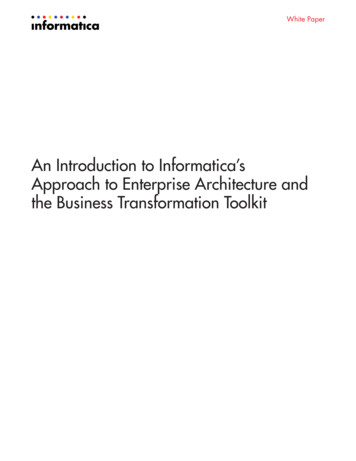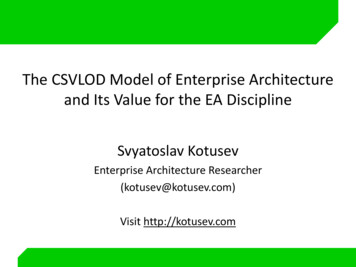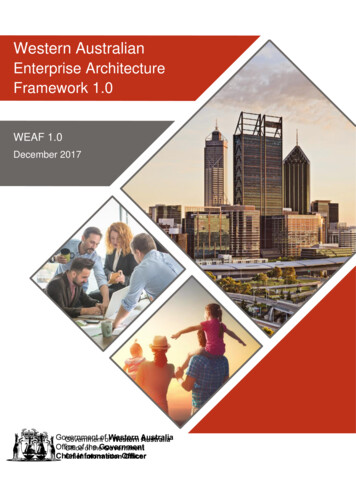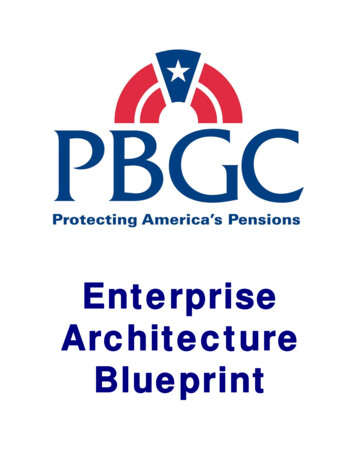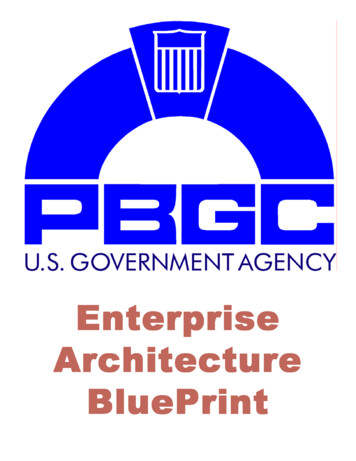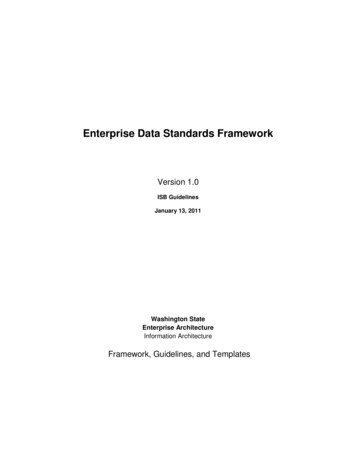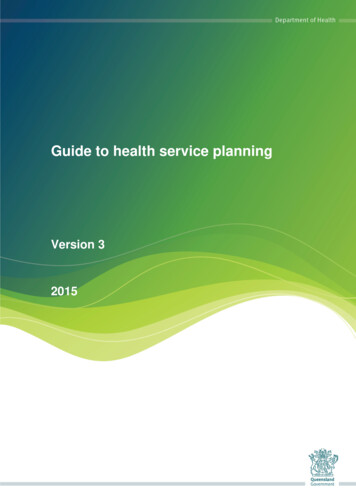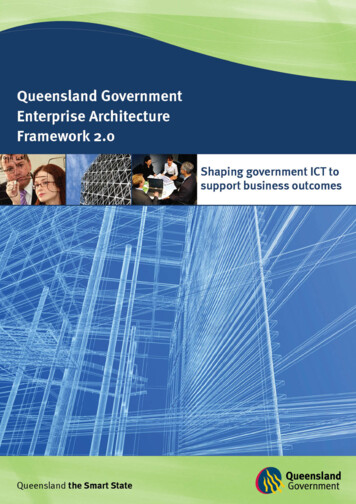
Transcription
Queensland Government Chief Information OfficePUBLICQueensland Government Enterprise Architecture Framework 2.0Document detailsDocument nameQueensland Government Enterprise Architecture Framework 2.0Version number1.0.0Publication dateSecurity classificationPUBLICDate of review of security classification : 7 April 2009AuthorityQGCIOAuthorQueensland Government Chief Information Office (EnterpriseArchitecture & Strategy)Documentation statusWorking draftConsultation release; Final versionContact for enquiries and proposed changesAll enquiries regarding this document should be directed in the first instance to:Director, Enterprise Architecture and Strategy,Queensland Government Chief Information Officeqgcio@qld.gov.auAcknowledgementsThis version of the QGEA Framework was developed and updated by the Enterprise Architecture andStrategy Unit, Queensland Government Chief Information Office.In addition, feedback was received from a number of staff from various agencies, which was greatlyappreciated.CopyrightQueensland Government Enterprise Architecture Framework 2.0Copyright The State of Queensland (Department of Public Works) 2009LicenceQueensland Government Enterprise Architecture Framework 2.0 by Queensland Government ChiefInformation Office is licensed under a Creative Commons Attribution-Noncommercial-Share Alike 2.5Australia License. Permissions may be available beyond the scope of this licence. Seewww.qgcio.qld.gov.au.Information securityThis document has been security classified using the Queensland Government Information SecurityClassification Framework (QGISCF) as UNCLASSIFIED (PUBLIC) and will be managed according to therequirements of the QGISCF.Version 1.0.0iPUBLIC
Queensland Government Chief Information OfficePUBLICQueensland Government Enterprise Architecture Framework 2.0ForewordGovernments face increasing demands for improved service delivery, expanding responsibilities in relation tomaintaining the social fabric, and the need to advance social justice while fiscally constrained.In response, the Queensland Government is committed to managing its information and exploiting ICT tomanage its internal processes more effectively and achieve greater efficiencies. This commitment is crucialto maintaining and improving service levels to the public, enabling sustainable government operations andhelping to build a strong, green, healthy, smart and fair Queensland.Enterprise Architecture (EA) has been identified as the most appropriate decision making and managementframework for enabling government and agencies to collaboratively provide seamless services andmaximally leverage existing investments.At the highest level, EA is about organising an enterprise’s resources – its services, processes, information,applications, and technology infrastructure – and establishing technical choices and a supporting set ofpolicies which help achieve desired business outcomes, technical standardisation and integration.The QGEA is a tailored EA which delivers a comprehensive set of processes, frameworks, policies,guidelines and tools to describe how the Queensland Government organises its resources to support servicedelivery.The QGEA assists agencies, multi-agency projects, shared service providers and whole-of-Governmentinitiatives to: deliver services in a coordinated, cost effective andefficient manner improve the integration and alignment of decisionmaking across the Queensland Government support coordinated decision making about strategicdirections, policies and standards use information and ICT to achieve their businessobjectives guide the development, use, and management ofinformation and ICT resources over time position themselves for future needs.The Queensland Government EnterpriseArchitecture (QGEA) provides thedecision making and managementstructures to support the development ofbetter services for Queenslanders, moreefficient and effective use of informationand ICT in government and effectivepartnering with the private sector throughthe application of whole-of-Government,cross agency and agency informationand information communicationstechnology policies and practices.The QGEA is a federated architecture, which acknowledges that the Queensland Government is a singleenterprise composed of autonomous agencies. Agencies are responsible for their own enterprisearchitectures, yet are able to leverage and contribute to whole of-Government architectures and investmentsthrough a single consistent framework.Since its publication in 2004, the original GEA Framework has been the subject of constant refinement andevolution to support EA across the Queensland Government. The QGEA Framework 2.0 represents thelatest iteration. It fully supports the information management and ICT governance arrangementsimplemented in 2007 as the result of the SDPC report into ICT governance in the Queensland Governmentand Executive Government’s 2008 decisions regarding revised ICT governance arrangements in theQueensland Government.The QGEA Framework 2.0 is an important step in the unification of strategy, architecture and informationpolicy across business, information, application and technology dimensions of the Queensland Government.Version 1.0.0iiPUBLIC
Queensland Government Chief Information OfficePUBLICQueensland Government Enterprise Architecture Framework 2.0Contents1Introduction. 11.1 Outline of this document . 11.2 Enterprise architecture in Queensland Government. 12Overview of the QGEA Framework. 32.1 Key artefacts . 32.2 Authority and approval . 42.3 The development and consultation process . 52.4 Compliance, review and exceptions . 53The QGEA Framework in detail. 63.1 QGEA Framework abstract model . 63.1.1Context. 73.1.2Artefacts. 73.1.3Portfolios . 83.2 QGEA Framework meta model . 83.2.1QGEA Framework concepts . 103.2.2QGEA Framework outputs. 124Using the QGEA Framework . 154.1 Development of QGEA artefacts. 154.2 Responsibility for producing QGEA artefacts. 194.3 Governance of the QGEA Framework and artefacts . 214.4 Agency compliance with the QGEA artefacts . 244.4.1Understanding compliance . 244.4.2Demonstrating compliance . 254.4.3Agency exceptions. 274.4.4Agency reporting. 274.5 Agency internal use of the QGEA Framework . 284.6 Combining the QGEA Framework with other EA frameworks . 29Appendix AHistory behind the QGEA. 30Appendix BQGEA deliverable and artefact type definitions . 33Appendix CSupporting the QGEA. 43Version 1.0.0iiiPUBLIC
Queensland Government Chief Information OfficePUBLICQueensland Government Enterprise Architecture Framework 2.0List of tablesTable 1: Overview of the QGEA artefact types . 3Table 2: QGEA Cycle description. 16Table 3: QGEA context and artefact co-ordination responsibility. 20Table 4: Operational and governance roles for the QGEA. 23Table 5: Example QGEA target compliance. 25Table 6: Policy and requirement compliance states. 26Table 7: Position and target compliance states. 26Table 8: Major events in the history of the QGEA . 30Table 9: QGEA deliverable and artefact type definitions. 34Table 10: Summary of QGEA support responsibilities . 43List of figuresFigure 1: The QGEA Framework abstract model . 6Figure 2: The QGEA Framework meta model. 9Figure 3: The core concepts hierarchy within the QGEA Framework . 10Figure 4 Mechanisms . 12Figure 5 Tools. 14Figure 6: The QGEA Cycle. 15Figure 7: QGEA artefact links. 18Figure 8: Gartner's concentric architecture team structure . 19Figure 9: Major Queensland Government ICT governance bodies. 21Figure 10: Agency application of the QGEA Framework. 28Version 1.0.0ivPUBLIC
Queensland Government Chief Information Office1PUBLICQueensland Government Enterprise Architecture Framework 2.0IntroductionThe development of an enterprise architecture and use of supporting enterprise architectureframeworks is not unique to the Queensland Government. Government jurisdictions and manyprivate sector organisations use enterprise architectures. Queensland Government’s use ofenterprise architecture, which dates back to the late 1990s with the original Government InformationArchitecture, makes it a leading example of whole-of-Government enterprise architecture inAustralia.This document describes the Queensland Government Enterprise Architecture (QGEA) Framework,including the underlying meta model. It also describes the agency contribution process, includinggovernance and compliance.It has been produced for the use of officers within the Queensland Government involved ingovernance and delivery of ICT-enabled initiatives, ICT or business planning, business servicedesign, portfolio analysis and management and other related business service and planningfunctions.1.1Outline of this documentSection 2 of this document provides an overview of the QGEA Framework and its operation, andprovides detail for most readers, including non-ICT officers who want to familiarise themselves withthe QGEA Framework and resulting QGEA 1 .Sections 3 and 4 provide more detail regarding the QGEA Framework and are intended for thoseofficers who will manage or contribute to the QGEA or who manage implementation of the QGEAwithin agencies and require in-depth knowledge of the definition and operation of the QGEAFramework.Appendix A contains a history of the QGEA, including its emergence as a key aspect of QueenslandGovernment ICT policy and governance processes.1.2Enterprise architecture in Queensland GovernmentThe Queensland Government views enterprise architecture as:Organising an enterprise’s resources – its services, processes, information, applications, andtechnology infrastructure – and establishing a set of policies and technical choices to achievedesired business outcomes, technical standardisation and integration.To achieve effective enterprise architecture requires the application of a comprehensive and rigorousmethod for describing a current and future structure and behaviour for the Government’s processes,information, applications, technology and supporting human resources. This will enable alignmentwith current strategic directions.Although often associated strictly with information and communications technology, EA relates to thepractice of business strategy, efficiency and effectiveness. It captures, documents, classifies andanalyses all aspects of an enterprise in order to make the information relevant for different types ofdecision makers, such as business managers, business analysts, and technology specialists.1The term “QGEA” is used to describe the collection of various enterprise architecture artefacts that are created underthe QGEA Framework. Throughout the document, care has been taken to only use QGEA when referring to themanifestation of the Queensland Government’s enterprise architecture in accordance with the framework.Version 1.0.0Page 1PUBLIC
Queensland Government Chief Information OfficePUBLICQueensland Government Enterprise Architecture Framework 2.0The QGEA Framework supports enterprise architecture activity within the Queensland Governmentby defining: architecture practices to help drive business management improvements across theQueensland Government the agreed standard architecture abstraction levels across the Queensland Government a means to establish a standard and coherent set of classification or domain models of thewhole-of-Government enterprise architecture a set of common artefact types in the form of strategies, principles, policies, requirements andother artefacts used to form the basis of the whole-of-Government target enterprise architecture a framework within which traditional enterprise architecture artefacts can be accommodated the means to describe the whole-of-Government target enterprise architecture mechanisms and tools for alignment with the whole-of-Government target enterprisearchitecture the governance and contribution process for the development, use and update of enterprisearchitecture artefacts.Version 1.0.0Page 2PUBLIC
Queensland Government Chief Information Office2PUBLICQueensland Government Enterprise Architecture Framework 2.0Overview of the QGEA FrameworkThe QGEA Framework establishes a consistent structure for the Queensland Government’sinformation management and ICT policy. It provides: a means to define classification frameworks covering business processes and services, theinformation they use, and the applications, technology and information security elements thatsupport them a means to describe the current state of the Government’s investment in information and ICT processes for development, management, approval and compliance of strategy, policy andrelated artefacts.In summary, the QGEA Framework provides a means for the Government to define policy,requirements and targets which drive agencies in supporting the Government’s priorities andproviding services to help build a strong, green, healthy, smart and fair Queensland.2.1Key artefactsThe QGEA Framework describes a hierarchy of products (commonly called artefacts) as outlined inTable 1 below. The key enterprise architecture artefacts under the framework are InformationStandards, QGEA policies, and QGEA positions. All of these artefacts support the Government’soverall vision as articulated in Towards Q2 and other whole-of-Government statements.Table 1: Overview of the QGEA artefact typesArtefact typeFocusDescriptionPrincipleWhat are thebeliefs and valuesthat will guide theGovernment toachieve its vision?These represent the core beliefs and values of the QueenslandGovernment in relation to the management of information andunderpinning technologies. They influence decisions madeabout the various resource and initiative portfolios across thesector and supporting agency processes.StrategyWhat generaldirection needs tobe taken?Strategies are short high-level documents intended to gain inprinciple agreement from senior executives to a general courseof action. The course of action will achieve an agreed desiredfuture state or goal in support of the Government’s vision in theform of ambitions and priorities. To that end, strategiesestablish a baseline of the current environment; identify thedrivers that are leading to the need for change to a particularenvironment; articulate the future desired environment; andpropose a series of actions to realise that future desired state.Version 1.0.0Page 3PUBLIC
Queensland Government Chief Information OfficePUBLICQueensland Government Enterprise Architecture Framework 2.0Artefact typeFocusDescriptionInformationStandard /QGEA PolicyWhat are thespecific directions,constraints andrequirements whichwill achieve theGovernment’sstrategies?These artefacts are clear and specific statements of directionbased on general principles which support achievement of longterm strategies or provide a response to issues. They includedetailed constraints and compliance requirements and in doingso they provide agencies with an indication of the level ofdiscretion available when making decisions.PositionWhat targets mustbe met to realisethe stated policyoutcomes?These provide detailed goal statements relating to eitherpolicies or requirements and the associated performance orobjective measures that indicate realisation of these goals.ToolsHow are the targetsand policies to bemet?This is a general category for a range of supporting tools whichassist agencies and initiatives in the implementation ofstrategies, policies and positions. Virtually any usefulinformation may be published in the QGEA as a tool. Commonartefacts include definition papers, guidelines, templates,implementation advice and methodologies.Information Standards and QGEA Policies are essentiallyequivalent in their function and are identified in the QGEAframework meta model as consisting of policy and requirementelements.The publication of a policy and its associated requirements as either an Information Standard orQGEA Policy is determined primarily on the context. Policies and requirements associated with thebusiness or information layers of the QGEA, or those which address broad business issues, arepublished as Information Standards. Policies and requirements related to applications, technology orspecific practices or methodologies are generally published as QGEA policies.For further information regarding the artefact types of the QGEA see Section 3 The QGEAFramework in detail.2.2Authority and approvalThe QGEA Framework was developed to support the mandated legislative provisions that deal withICT policy in the Queensland Government, for example the Financial Management Standard 1997,established under the Financial Administration and Audit Act 1977 and the Public Records Act 2002.The QGEA Framework also supports the Executive Government-approved administrativearrangements for ICT governance in Queensland as agreed in November 2008.Consistent with these administrative arrangements, and those that have supported the InformationStandards process for many years, the QGEA Framework, its associated policies, requirements andtargets are issued by the Queensland Government Chief Information Office (QGCIO) after approvalby the Queensland Chief Information Officer in consultation with the Strategic Information and ICTCEO Committee (as required) 2 .For further information regarding governance of the QGEA see Section 4.3 Governance of the2Under the Executive Government decision taken on 24 November 2008, the Department of Public Works wasdesignated as the lead agency for whole-of-Government ICT, and the Director-General directed to take on the role ofQueensland Government Chief Information Officer.Version 1.0.0Page 4PUBLIC
Queensland Government Chief Information OfficePUBLICQueensland Government Enterprise Architecture Framework 2.0QGEA Framework and artefacts.2.3The development and consultation processInformation Standards, policies and positions are developed using a defined process (see Figure 6on page 15) in keeping with the Australian Policy Cycle 3 that includes: pro-active identification of issues and risks associated with current and emerging business,service delivery, information management and ICT changes and issues analysis to quantify the nature and scale of the issues being faced by government in order toidentify the policy options available to address them development of the most appropriate principles, policies, requirements and targets to achievethe desired results consultation with impacted stakeholders, including review by specialist reference groupsfollowed by general distribution to the agencies of the Queensland Government and, in somecases, external stakeholders such as industry groups submission to the appropriate governance bodies and approval authority implementation of the policy, including undertaking business cases and resulting projects evaluation of the principles, policies, requirements and targets through regular reviews,monitoring and annual agency reporting of compliance.For further information regarding development of the QGEA see section 4.1 Development of QGEAartefacts.2.4Compliance, review and exceptionsThere can be significant legal consequences to the Queensland Government from third partieswhere an agency fails to implement and adhere to mandatory elements of the QGEA. A key strengthof the QGEA Framework is the compliance reporting process which allows the QGCIO to monitor theeffectiveness of ICT policy across the sector.Agency compliance with QGEA artefacts is demonstrated by meeting criteria relating to theimplementation of Information Standards, policies, requirements and targets, which means thatagencies must show evidence of implementation action. This evidence is presented through anannual planning and reporting process consistent with the requirements of Section 22 of theFinancial Management Standard and the November 2008 Executive Government decision relating torevised ICT governance reporting requirements in the Queensland Government 4 .However, the variations and demands of agency service delivery require some flexibility. For thisreason the QGEA Framework includes a formalised exception process approved by ExecutiveGovernment for the achievement of the targets associated with positions.The exception process requires the requesting agency to undertake its own risk assessment andthen provide details regarding the impact of non-compliance, remedial action to be undertaken,associated costs and benefits of non-compliance and agreement to a timeframe to achieveconsistency. For further information regarding agency exceptions see section 4.4.3 Agencyexceptions.3The Australian Policy Cycle forms the approved policy handbook for the development of government policy inQueensland. See http://www.premiers.qld.gov.au/About the department/publications/policies/Governing Queensland/(accessed 19 December 2008).4Queensland Government agencies wishing to access specific details of this decision should consult with their localCabinet Legislation and Liaison Officer.Version 1.0.0Page 5PUBLIC
PUBLICQueensland Government Enterprise Architecture Framework 2.0Queensland Government Chief Information Office3The QGEA Framework in detailThis section details the technical composition of the QGEA Framework. An abstract model providesa high-level overview of the QGEA Framework. This abstract model is supported by a meta modelwhich contains the detailed elements of the QGEA Framework, including definitions of key artefacts.3.1QGEA Framework abstract modelThe QGEA Framework is conceptually divided into three key elements: context, artefacts andportfolios as shown in Figure 1 below.Queensland Government Enterprise Architecture Framework 2.0ContextInformationSecurityBusinessBusiness Classification FrameworksInformationInformation Classification rksApplicationApplication Classification FrameworksTechnologyTechnology Classification hole-ofGovernmentCross CurrentResourcesOther ToolsInitiativesFutureStateAlignsFigure 1: The QGEA Framework abstract modelA key strength of the QGEA Framework is the links between the elements. For example, theeffectiveness of artefacts are measured through alignment of the portfolios, and the portfolios areanalysed using context set by the various classification schemes within the QGEA.Each of the elements of the QGEA Framework’s abstract model is described in the following section.Version 1.0.0Page 6PUBLIC
Queensland Government Chief Information OfficePUBLICQueensland Government Enterprise Architecture Framework 2.03.1.1 ContextThe context is the structure that allows for organisation and navigation of the QGEA. It compriseshorizontal layers such as the business, information, application and technology layers, and verticalslices such as the information security slice. Within each of these layers and slices, a hierarchy ofclasses or categories exist, known as domains.While the abstract model shows only four layers and one slice, within these slices are many differentclassification frameworks. These are critical to the QGEA because they: set the specific context for artefacts such as strategies, policies and positions act as an index to allow agencies to navigate the QGEA to determine which apply to a particularlayer, slice or domain provide a means for data collection and analysis of the architectural information associated withcurrent resources used and initiatives 5 being undertaken at all levels of the Government.The Queensland Government’s major endorsed QGEA classification schemes 6 include the: Business Process Classification Framework 7 Information Classification Framework Application Classification Framework 8 Technology Classification Framework 9 Information Security Framework 10 .3.1.2 ArtefactsThe artefacts are the mechanisms 11 and supporting tools that guide the development, use andmanagement of services, processes, information, applications and technologies across theGovernment to achieve the target enterprise architecture and whole-of-Government outcomes.The artefacts are the active elements of the QGEA. They are developed using input from across thesector and from analysis of the architectural information 12 associated with various assets andinitiatives and are prescriptive in nature.There is a hierarchical relationship between various artefacts that represent alignment on thedirections established through these artefacts. In particular, principles, strategies and policies have ahierarchical relationship whereby principles provide a driver for strategies, which in turn formulatepolicies.5The term “initiative” is used by QGCIO in preference to “project” to describe any investment in change, because suchchanges may be run as a program, project or one-off operational activity.6The QGEA has numerous classification schemes, but these five represent the most visible and widely used of thosecurrently published.7This was originally known simply as the Business Portfolio Framework, based on the Process Classification Frameworkfrom the American Productivity and Quality Centre (APQC).8The Application and Technology classification frameworks, formerly portfolio frameworks, were o
whole-of-Government enterprise architecture a set of common artefact types in the form of strategies, principles, policies, requirements and other artefacts used to form the basis of the whole-of-Government target enterprise architecture a framework within which traditional enterprise architecture artefacts can be accommodated


